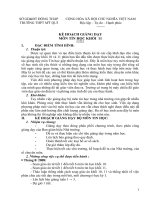BÌNH DIỆN LIÊN VĂN HÓA TRONG GIẢNG DẠY NGOẠI NGỮCROSS – CULTURE COMMUNICATION FOR ELTBÀI TẬP CUỐI KÌ – FINAL ASSIGNMENT
Bạn đang xem bản rút gọn của tài liệu. Xem và tải ngay bản đầy đủ của tài liệu tại đây (127.35 KB, 11 trang )
ĐẠI HỌC QUỐC GIA HÀ NỘI
TRƯỜNG ĐẠI HỌC NGOẠI NGỮ
BÌNH DIỆN LIÊN VĂN HÓA TRONG GIẢNG DẠY NGOẠI NGỮ
CROSS – CULTURE COMMUNICATION FOR ELT
BÀI TẬP CUỐI KÌ – FINAL ASSIGNMENT
Giảng viên phụ trách: GS, T.S Nguyễn Quang
Lớp: PG16
Học viên: Nguyễn Thị Vân Anh ( 2/8/1986)
Đào Hồng Hạnh (03/04/1986)
Lê Thị Ly(09/12/1990)
Trần Thạch Thủy(20/07/1989)
Phí Lương Vân(01/09/1988)
Khóa học: 2013 – 2014
Hà Nội – 2013
ACKNOWLEDGEMENTS
Firstly, we want to express our deep gratitude to my lecturer, Ph.D Nguyen Quang for
his lectures during the class time, his great enthusiasm and useful pieces of advice if
necessary. We also would like to thank our classmates and friends for their timely
help and good cooperation during the period we did this assignment. We ourselves are
responsible for what we represent in this paper.
Culture shock is one of the most controversial issues arousing people’s attention all
over the world, especially those wanting to live or study in foreign countries. It’s
undeniable that anyone going to live in a new country will experience a degree of
culture shock within a certain period of time after their arrival. Culture shock may be
considered to come from mis – interpretation of cultural values, beliefs, behaviors,
and norms of the new society. People use their own cultures as the standard for
interpreting, judging and behaving in the new culture in an ineffective way.
Individuals don’t know the systems of rewards and punishment associated with the
verbal and nonverbal behaviors in the host culture. Thus, there is an occurrence of
culture shock. From our point of view, cross – cultural learning plays a significant role
before people go to the target country. Therefore, this paper aims at giving a short
introduction to the target culture, specifically the American and illustrating some
potential areas of culture shock in terms of verbal and nonverbal behavior students can
experience on their two – month student – exchange programme in the United States.
I. VERBAL COMMUNICATION
According to Levine and Adelman (1993), verbal communication is “the spoken
communication, including the use of words and intonation to convey meaning”.
Verbal communication is defined as “the process of sharing meaning by means of
intralinguistic factors or intralanguage” (Nguyen Quang, 2006). Moreover, verbal can
be spoken or written language. As a result of differences in language, people in
different cultures will think about, perceive, and behave toward the world differently.
Let’s take a look at the differences between verbal behavior of American and this of
Vietnamese which can be potential culture shock issues for students enrolling student-
exchange programme.
Firstly, there are a lot of things need to be considered in transferring from one
language to other which can be divided into three types: linguistic transfer,
communicative transfer and cross-cultural transfer.
In linguistic transfer, the language can be absolute transferred or relative transferred.
For instance, a simple sentence in English such as “There is a vase on the table” can
be totally linguistic interpretted into Vietnamese equipvalent “Có một cái lọ hoa trên
bàn”. Another sentence in English is only relatively transferred from “She’s got
married for two years” to “Cô ấy đã kết hôn được 2 năm rồi”. One more example of
relatively interpretation from English to Vietnamese is “She don’t want to talk to him
anymore” which can be transferred to “cô ấy không muốn nói chuyện với anh ta nữa”.
The second type is communicative transfer which is more complex and can cause
culture shock for foreigners. For example, the English saying “search me” can be
wrongly interpretted to “tra cứu tôi đi” and it can lead to misunderstanding. According
to communicative purpose, the saying must be transferred to “hỏi tôi thì hỏi cái đầu
gối ấy”. Another example is “if you ask me, she’s the type woman who never says no
to any man”. If we interpret the sentence into “nếu bạn hỏi tôi, cô ấy là loại đàn bà
không bao giờ nói không với đàn ông”, the meaning will be too complicated to
understand. In term of communicative context, the suitable Vietnamese equipvalent
can be “nếu anh hỏi thì tôi xin nói, cô ấy là loại dại trai”. The meaning can be
correctly transferred and easier to understand.
The last type and also the most important one in culture shock areas is cross-culture
transfer. For instance, at 8.30 pm an English man talk to his wife “Honey, it’s time for
tea”. If we interpret it into “Em yêu, đến giờ uống trà rồi”, it doesn’t suitable in
Vietnamese culture and can lead to misunderstanding. That’s why we need to consider
the culture of both two languages before translating to avoid miscommunication.
“How are you?” is another example. In American, the question is a greeting sentence
only, so if we transfer it to “bạn thế nào”, the meaning can be changed. Therefore, it
can cause verbal behavior culture shock. In Vietnamese, we often use the question
“chào bác, bác xơi cơm chưa ạ?” to say hello to older people, but if we transfer it into
“do you have lunch?”, listener can understand it as a question about whether they eat
their lunch or not.
Secondly, politeness is a huge potential culture shock for Vietnamese student studying
in America. According to Nguyen Quang (2006) politeness is “any communication act
(verbal and/or nonverbal) that is intentionally and appropriately meant to make
another person/ other people feel better or less bad.” If we use communication act
intentionally to make another person feel better, it is called positive politeness.
Positive politeness is also defined as “any communication act (verbal and/or
nonverbal) that is intentionally and appropriately meant to show speaker’s concern to
addressee, thus, enhancing the sense of solidarity between them”. (Nguyen Quang,
2006). The other type of politeness is negative politeness which is “any
communicative act (verbal and/or nonverbal) that is intentionally and appropriately
meant to show that the speaker does not want to impinge on the addressee’s privacy,
thus, maintaining the sense of distance between them”. So in the forein country such
as American, we should learn to be positive politeness and avoid negative politeness.
Let’s discuss the strategies below.
Firstly, positive politeness can be obtained through a lot of strategies. For example,
noticing attend to the hearer’s interest, wants and needs like asking question such as:
(Your friend must be thirsty) Do you want to have some orange juice?. Another
strategy is exaggerate interest, approval, sympathy of the hearer. For instance, “you’re
such a genius” or “oh, yeah, you’re perfectly right about it”. Thirdly, positive
politeness can be shown through indensify interest to the hearer by using sentences
like “what do you think I see? Everyone is still stay outside”. The strategies left are
using groupidentity markers, avoiding disagreement,raising common groups, offering,
promising, being optimistic, including both the speaker and hearer in the activity,
giving or asking for reason, assuming or asserting reciprocity, giving gifts and so on.
Secondly, negative politeness strategies can be being conventionally indirect, making
questions, being persimistic, minimising the imposation, giving deference,
apologising, impersonalizing speaker and hearer, nominalising, redressing other wants
to hearer and so on. Specifically, we can use sentences such as “I wonder if you could
possibly”, “I just want to ask you if I can borrow this paper”, “I’d be grateful if you
would”.
In summary, there are quite a lot of verbal behavior which can cause culture shock.
Two main areas are transfering and showing politeness. The student need to be
prepared about those issues to avoid culture shock when studying in America.
II. NONVERBAL BEHAVIOR:
Understanding nonverbal communication in the United States can help make social
interactions more productive. Recognizing the American's need for personal space,
direct eye contact and restraint from physical contact helps people reach their
communication goals with less potential for confusion.
(By Sherri Jens)
We will look at nonverbal communication, a form of communication rather than using
speech, in United State of America, including
+ Eye contact
+ Facial expressions,
+ Other body language,
+ Personal space,
+ Touching
Eye Contact
Latin cultures tend to rely more on eye contact in communication than do non-Latin
cultures. In the U.S. and in Arabic cultures, direct eye contact is often seen as a sign of
honesty, whereas in some Asian, Middle-Eastern and Native-American cultures, it's
considered rude. In the United States, eye contact can indicate degree of attention or
interest. It can be used to indicate attraction, to establish power, indicate emotion, and
influence attitude. In most part of United States, direct eye contact could be
considered as a positive trait. Children are encouraged to look the person addressing
them in the eye. However, due to the diversity in the USA, that is not a universal truth.
African-Americans tend to use more eye contact when they are speaking, but less
when they are listening; Anglo-Americans tend to use more eye contact when
listening, but less when speaking. It is noticed as a difference since in Asian culture
such as in Vietnam, avoiding eye contact is a kind of way to show respect. Extended
eye-contact in Vietnam culture may be taken as disrespectful or a challenge to
authority.
Facial Expressions
All cultures seem to express with the same basic facial expressions the basic emotions
of anger, grief, happiness and fear. But the acceptability of such expression varies
from culture to culture. Many Asian cultures don't easily express anger or grief on
their faces, while American culture permits open expressions of grief.
Gestures
Even a gesture as simple as pointing can lead to cross-cultural miscommunication.
Among the most potent forms of non-verbal communications is gestural. There are too
many differences in gestures to handle them in a meaningful way here. Some
examples of gestures that may not translate include pointing. Pointing with a single
finger is considered rude in many Asian cultures. Better there to indicate direction by
gesturing with a whole hand. Even among those cultures that use a single finger to
point, there is variation. In the US , people use the index finger to point. The gesture
that Americans use to indicate everything is okay, is a very offensive gesture in many
parts of the world.
As for the Victory symbol of American, for example, when George
Bush visited Australia, he flashed them a V-for victory/peace sign from his limo. The
gesture is normally done with the palm facing out, but for most Americans, it does not
matter. President Bush, unfortunately made the sign with the back of his hand facing
towards the crowd. In Australia and in the UK , this is an equivalent of flipping
someone the bird, or saying "Up yours."
In America and in most parts of Europe, showing someone a closed fist with your
thumb sticking in the air is a sign of approval. In many Asian or Islamic parts of the
world, it is an insulting gesture.
While in the USA, men greeting each other with a handshake is the norm, in other
parts of the world they might greet each other with a kiss. There are cultures that
consider two men walking hand-in-hand to standard behavior. In the United States,
two men holding hands would indicate a romantic relationship
Personal space
Members of an individualistic society, Americans in the US prefer comparatively little
touching and relatively large personal space. Because of increased personal space
requirements, frequent and direct eye contact and apparent discomfort from touching,
foreigners may sometimes view US citizens as cold, rude or uninterested.
Fun Facts
Most people in the US prefer to stand at an arm's length distance from others. While
seeming friendly to Americans, the US hand gesture for "come here" is actually
considered an insult in some cultures like Vietnam
Touch
In general, Americans touch in public more than Vietnamese do. Hugging or kissing
as a gesture of greeting or leave-taking. Americans do not touch in public as much as
people in some European and South American cultures do, however, they touch more
than Vietnam people do, especially in a situation such as greeting or saying good-by
to someone at an airport.
In addition, almost all the touching for American was widespread.
Meeting People
There are many nonverbal ways Americans use to greeting people. The first way is to
shake hands. In the US, people usually shake hands firmly, and shake hands with
people of the opposite gender. In their view, how to shake hands is a measure of the
character. Americans often shake hands when being introduced to someone. In more
informal situations, it is common for people not to shake hands unless a long period of
time has elapsed and the people feel comfortable with each other and their mutual
friendship. However, in formal business situations people most often greet each other
with a handshake every time they meet or say good-bye. As a gesture of friendliness,
if a person offers his hand, the opposite person should shake it. It could be considered
to be rude if one didn't. Many times men are the only ones who shake hands in a
mixed group. It is customary for a man to shake a woman's hand only if she offers her
hand first, though this is somewhat of an old-fashioned custom and today offering a
hand to a woman is accepted, if not expected.
The second way is to use eye – contact. They always look people in the eye when
shaking hands or conversing. Lack of eye contact is interpreted as lack of honesty,
reliability and cheviots in the U.S. Meanwhile, it is usual that the Vietnamese avoid
eye contact with other people when speaking or being spoken to. Looking into
somebody's eyes, especially when this person is of a higher status (in age, in social or
family hierarchy) or of a different sex, usually means a challenge or an expression of
deep passion. The proper respectful behavior is to avoid eye contact in talking who is
not an equal or the same sex.
III. Some solutions to deal with culture shock when you come to an English-
speaking country ( USA)
The Adjustment Process in a New Culture
Understanding the cultural adjustment process is one of the useful way which can help
people cope with the intense feelings that they may experience when beginning the
life in the U.S. Each stage in the process is characterized by “symptoms” or outward
signs typifying certain kinds of behavior as follows:
1. “Honeymoon” period: Initially, many people are fascinated and excited by
everything new. The visitor is elated to be in a new culture.
2. “Culture Shock”: The individual is immersed in new problems: housing,
transportation, shopping, and language. Mental fatigue results from continuous
straining to comprehend the new language.
3. Initial Adjustment: Everyday activities such as housing and shopping are no longer
major problems. Although the visitor may not yet be fluent in the language spoken,
basic ideas and feelings in the second language can be expressed.
4. Mental Isolation: Individuals have been away from their family and friends for a
long period of time and may feel lonely. Many still feel they cannot express
themselves as well as they can in their native language. Frustration and sometimes a
loss of self-confidence result.
5. Acceptance and Integration: A routine (e.g., work, business, or school) has been
established. The visitor has accepted the habits, customs, foods, and characteristics of
the people in the new culture. The visitor feels comfortable with friends, associates,
and the language of the country.
The following are some tips to help you deal with culture shock:
• Go out: Don’t sit in your apartment or the library every day. Find some campus
activities that sound interesting to you. By getting out and into social settings, you
will begin to become more comfortable with new customs.
• Get exercise: Exercise has been shown to reduce stress and fight depression. Take
a walk downtown or join an intramural sports team. Find some fellow students
who want to get active, and schedule a regular activity.
• Make friends: Make an effort to become friends with both Americans and with
other international students. The international students will be able to relate to your
feelings and may be able to offer advice and support. American friends can answer
general questions you have about life in the U.S. By making new friends, you will
reduce feelings of loneliness and will begin to form bonds with your new
surroundings.
• Learn about the new culture: Resist the urge to judge behaviors or practices that
are different from your own as being “bad” or “unintelligent”. Instead, try to learn
the reason behind the behavior. While you may not agree with the practice, you
will have a better understanding of how to respond when faced with it.
• Seek assistance: If you find that you cannot seem to adjust to the new culture,
make an appointment to speak with one of the staff in the Office of International
Programs. If you find that you are very depressed, make an appointment with the
Counseling Center. In both cases, your meeting will be completely confidential.
• Be patient: Most people require several weeks or more to feel comfortable in a
new culture. Give yourself time to adjust. Focus on the positive experiences, and
try to view negative experiences as learning opportunities.
REFERENCES
1. Back, K. and Harnish, R. (1973), Linguistic communication and Speech Acts,
Massachsettes: the MIT Press
2. Cottril, M (1994), Face, Politeness and Directness, University of Canberra
3. Deena, R. Levine and Mara, B. Adelman(1993), Beyond Language
4. Nguyễn Quang (2004). Một số vấn đề giao tiếp nội văn hóa và giao văn hóa. Nhà xuất bản Đại
học quốc gia Hà Nội.
5. Nguyễn Quang (2006). Giao tiếp phi ngôn từ qua các nền văn hóa. Nhà xuất bản khoa học xã
hội.
6. Nguyễn Quang (2007). Cách thức diễn đạt trong tiếng Anh – Ways of expressions in English.
Nhà xuất bản Từ điển Bách Khoa.
7. Differences between American and Japanese culture
8. Solution to avoid cultural shock: />









